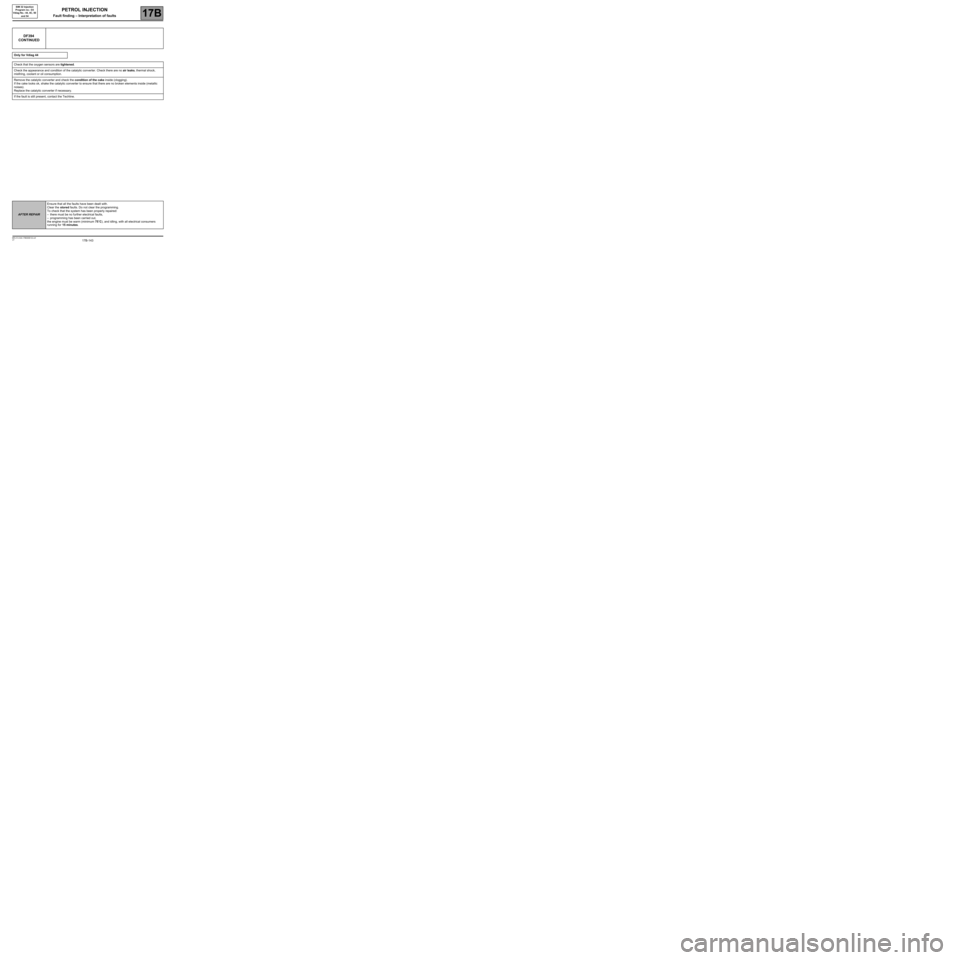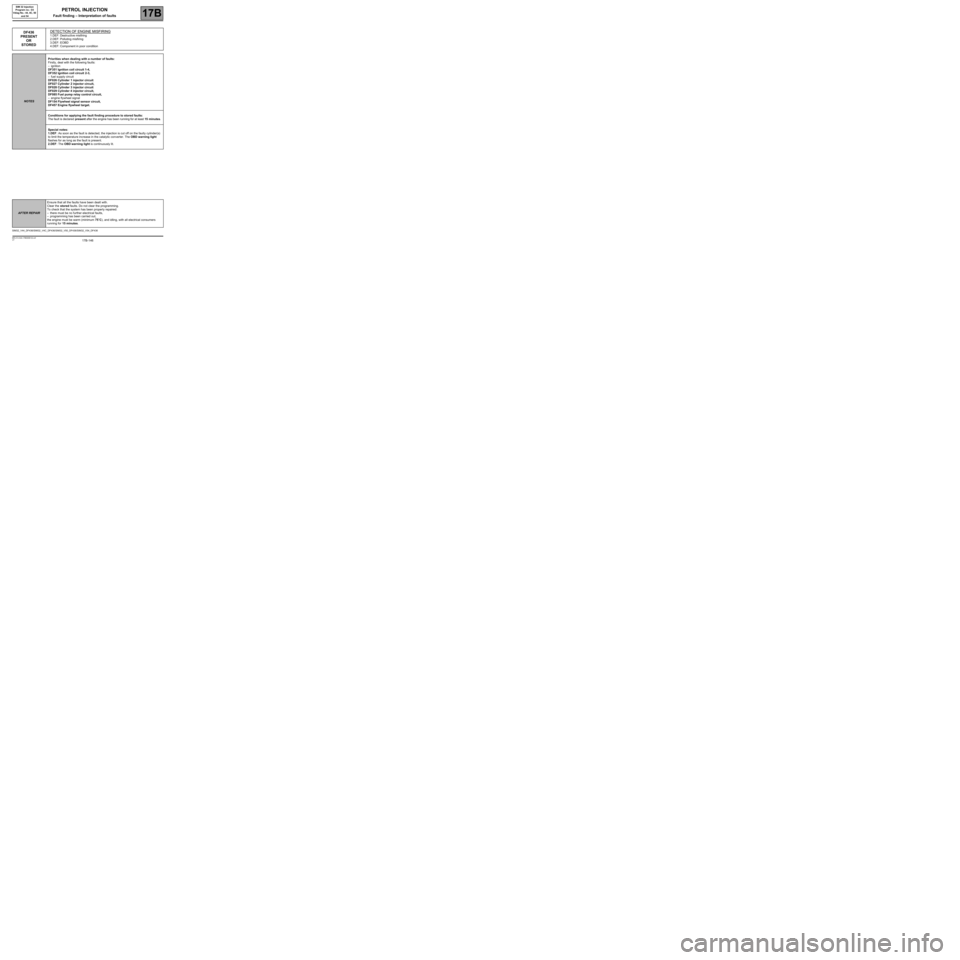2009 RENAULT TWINGO RS catalytic converter
[x] Cancel search: catalytic converterPage 105 of 348

17B-105V7 MR-413-X44-17B000$132.mif
PETROL INJECTION
Fault finding – Interpretation of faults17B
SIM 32 Injection
Program no.: D3
Vdiag No.: 44, 4C, 50
and 54
DF092
CONTINUED
Run command SC007 Run OBD Test: O2 sensors.
The aim of this scenario is to detect a fault causing the EOBD* threshold for pollutant emissions to be exceeded.
There are two kinds of oxygen sensor damage:
–mechanical damage to the component (breakage, cut in wire) which leads to an electrical fault,
–chemical or thermal damage to the component leading to a slower response time of the sensor and to the
increase in the average reaction time.
Before carrying out this test, repair all the electrical faults and clear the fault memory.
Deal first with the DF436 Misfiring detection fault and program the flywheel target ET089 Flywheel target
programming.
Perform this test when the engine is warm, which reduces the time it takes for the catalytic converter to heat up.
Fault finding is entirely autonomous. When completed, the throttle control ceases and the engine returns to idling
speed regulation operation.
At the end of this test, four different results are possible:
–status 1: Fault finding not carried out/impossible to establish the necessary conditions.
–status 2: Component in an average condition.
–status 3: Component in good condition.
–status 4: Component in poor condition.
When fault finding is completed and the result read, stop the engine and start it again to establish normal operating
conditions.
If the result is status 1: check for any faults, and the engine flywheel target programming using ET089
Programming engine flywheel target.
If the result is status 2 or status 4, replace the sensor.
If the result is status 3, the sensor is in good condition.
If the fault is still present, contact the Techline.
AFTER REPAIRIf the throttle valve has been replaced, program the throttle stops, RZ005 Programming.
Follow the instructions to confirm repair:
- If the fault is present, continue to deal with the fault.
- If the fault is stored, ignore it.
Deal with any other faults.
Clear the stored faults.
Page 116 of 348

17B-116V7 MR-413-X44-17B000$132.mif
PETROL INJECTION
Fault finding – Interpretation of faults17B
SIM 32 Injection
Program no.: D3
Vdiag No.: 44, 4C, 50
and 54
DF109
PRESENT
OR
STOREDLOW FUEL LEVEL MISFIRING
1.DEF: Destructive misfiring
2.DEF: Polluting misfiring
3.DEF: EOBD
NOTESPriorities when dealing with a number of faults:
Firstly, deal with the following faults:
–DF085 Fuel pump relay control circuit,
–DF026 Cylinder 1 injector circuit
–DF027 Cylinder 2 injector circuit, DF028 Cylinder 3 injector circuit,
–DF029 Cylinder 4 injector circuit,
–DF059 Misfiring on cylinder 1,
–DF060 Misfiring on cylinder 2,
–DF061 Misfiring on cylinder 3,
–DF062 Misfiring on cylinder 4,
–DF436 Combustion misfiring detection,
if they are present or stored.
Conditions for applying the fault finding procedure to stored faults:
The fault is considered present when the engine is running.
Special notes:
1.DEF: As soon as the fault is detected, the injection is cut for the faulty cylinder(s) to
limit the rise in temperature inside the catalytic converter. The OBD warning light
flashes for as long as the fault is present.
2.DEF: The OBD warning light is continuously lit.
Check:
–the level of fuel in the tank,
–the conformity and the grade of the fuel, apply test 1 Petrol conformity check,
–the fuel filter,
–the fuel pump,
–the fuel lines,
–the fuel pressure.
If there is no present or stored misfiring fault, the misfiring was caused by the low fuel level.
SIM32_V44_DF109/SIM32_V4C_DF109/SIM32_V50_DF109/SIM32_V54_DF109
AFTER REPAIRFollow the instructions to confirm repair:
- If the fault is present, continue to deal with the fault.
- If the fault is stored, ignore it.
Deal with any other faults.
Clear the stored faults.
Page 142 of 348

17B-142V7 MR-413-X44-17B000$133.mif
PETROL INJECTION
Fault finding – Interpretation of faults17B
SIM 32 Injection
Program no.: D3
Vdiag No.: 44, 4C, 50
and 54
DF394
PRESENT
OR
STOREDCATALYTIC CONVERTER OPERATING FAULT
1.DEF: Component in bad condition
2.DEF: EOBD
NOTESPriorities when dealing with a number of faults:
Deal with any other fault first.
Conditions for applying the fault finding procedure to stored faults:
The fault is declared present after the engine starts.
Special notes:
The OBD warning light is lit.
Use the Wiring Diagrams Technical Note for NEW TWINGO, E33, CLIO III,
or MODUS.
Only for Vdiag 4C, 50 and 54
Check the appearance and condition of the catalytic converter. Check there are no air leaks, thermal shock,
misfiring, coolant or oil consumption.
Run command SC006 Running OBD Test: catalytic converter. Before carrying out this test, repair all the
electrical faults and clear the fault memory. Check that fault DF436 Misfiring detection is not present and program
the engine flywheel target ET089 Flywheel target programming.
Carry out this test when the engine is warm, which reduces the time it takes for the catalytic converter to heat up.
At the end of this test, four different results are possible:
–Status 1: Fault finding not carried out/impossible to obtain the necessary conditions.
–Status 2: Component in an average condition.
–Status 3: Component in good condition.
–Status 4: Component in poor condition.
When fault finding is completed and the result read, stop the engine and start it again to establish normal operating
conditions.
If the result is status 1: check that there are no faults, and check the engine flywheel target programming using
ET089 Programming engine flywheel target.
If the result is status 2 or 4: replace the catalytic converter.
If the result is status 3: the catalytic converter is in good condition.
If the fault is still present, contact the Techline.
SIM32_V44_DF394/SIM32_V4C_DF394/SIM32_V50_DF394/SIM32_V54_DF394
AFTER REPAIREnsure that all the faults have been dealt with.
Clear the stored faults. Do not clear the programming.
To check that the system has been properly repaired:
–there must be no further electrical faults,
–programming has been carried out,
the engine must be warm (minimum 75˚C), and idling, with all electrical consumers
running for 15 minutes.
Page 143 of 348

17B-143V7 MR-413-X44-17B000$133.mif
PETROL INJECTION
Fault finding – Interpretation of faults17B
SIM 32 Injection
Program no.: D3
Vdiag No.: 44, 4C, 50
and 54
DF394
CONTINUED
Only for Vdiag 44
Check that the oxygen sensors are tightened.
Check the appearance and condition of the catalytic converter. Check there are no air leaks, thermal shock,
misfiring, coolant or oil consumption.
Remove the catalytic converter and check the condition of the cake inside (clogging).
If the cake looks ok, shake the catalytic converter to ensure that there are no broken elements inside (metallic
noises).
Replace the catalytic converter if necessary.
If the fault is still present, contact the Techline.
AFTER REPAIREnsure that all the faults have been dealt with.
Clear the stored faults. Do not clear the programming.
To check that the system has been properly repaired:
–there must be no further electrical faults,
–programming has been carried out,
the engine must be warm (minimum 75˚C), and idling, with all electrical consumers
running for 15 minutes.
Page 146 of 348

17B-146V7 MR-413-X44-17B000$133.mif
PETROL INJECTION
Fault finding – Interpretation of faults17B
SIM 32 Injection
Program no.: D3
Vdiag No.: 44, 4C, 50
and 54
DF436
PRESENT
OR
STOREDDETECTION OF ENGINE MISFIRING1.DEF: Destructive misfiring
2.DEF: Polluting misfiring
3.DEF: EOBD
4.DEF: Component in poor condition
NOTESPriorities when dealing with a number of faults:
Firstly, deal with the following faults:
–ignition
DF351 Ignition coil circuit 1-4,
DF352 Ignition coil circuit 2-3,
–fuel supply circuit
DF026 Cylinder 1 injector circuit
DF027 Cylinder 2 injector circuit,
DF028 Cylinder 3 injector circuit
DF029 Cylinder 4 injector circuit,
DF085 Fuel pump relay control circuit,
–engine flywheel signal
DF154 Flywheel signal sensor circuit,
DF457 Engine flywheel target.
Conditions for applying the fault finding procedure to stored faults:
The fault is declared present after the engine has been running for at least 15 minutes.
Special notes:
1.DEF: As soon as the fault is detected, the injection is cut off on the faulty cylinder(s)
to limit the temperature increase in the catalytic converter. The OBD warning light
flashes for as long as the fault is present.
2.DEF: The OBD warning light is continuously lit.
SIM32_V44_DF436/SIM32_V4C_DF436/SIM32_V50_DF436/SIM32_V54_DF436
AFTER REPAIREnsure that all the faults have been dealt with.
Clear the stored faults. Do not clear the programming.
To check that the system has been properly repaired:
–there must be no further electrical faults,
–programming has been carried out,
the engine must be warm (minimum 75˚C), and idling, with all electrical consumers
running for 15 minutes.
Page 169 of 348

17B-169V7 MR-413-X44-17B000$150.mif
PETROL INJECTION
Fault finding – Status summary table17B
SIM 32 Injection
Program no.: D3
Vdiag No.: 44, 4C, 50
and 54
* RCH: passenger compartment heating resistor
Tool statusDiagnostic tool title
ET075Pedal released and throttle closed
ET076Starting
ET077Impact detected
ET079Air conditioning present
ET081Accelerator pedal position
ET082Motorised throttle position
ET086Camshaft dephaser (Only for Vdiag 4C)
ET088Compressor actuation request
ET089Flywheel target programming
ET093Catalytic converter fault finding
ET094Upstream sensor fault finding
ET095Misfire fault finding
ET111RCH* number set
ET112RCH* cut-off
ET143Low-speed fan assembly relay control
ET144High-speed fan assembly relay control
ET233Clutch pedal
ET289Injection -> instrument panel connection
ET290Petrol pump relay control
ET300Richness regulation
ET340Request by Automatic Transmission for OBD warning light to come on (Only for CLIO III
or MODUS)
ET341Immobiliser code programmed
ET351Injection -> electronic stability program connection
ET357Low-speed fan unit relay connection
Page 196 of 348

17B-196V7 MR-413-X44-17B000$151.mif
PETROL INJECTION
Fault finding – Interpretation of statuses17B
SIM 32 Injection
Program no.: D3
Vdiag No.: 44, 4C, 50
and 54
ET054
CONTINUED
IDLING SPEED TOO LOW
Check:
–engine oil level (too high, splashing),
–that the exhaust pipe is not blocked (catalytic converter damaged),
–the cleanliness and conformity of the air filter,
–that the air inlet circuit is not blocked,
–that the throttle valve assembly is not clogged,
–the condition and conformity of the spark plugs,
–the fuel circuit sealing,
–the fuel pressure and the flow (see MR 392 (Clio III), MR 385 (Modus), MR 411 (New Twingo), or MR 442
(E33), Mechanical, 13A, Fuel supply),
–the condition and cleanliness of the injectors,
–the cylinder compression's,
–the timing setting.
Repair or replace the faulty components, if necessary.
IDLING SPEED TOO HIGH
Check:
–engine oil level (too high, splashing),
–for the fittings in the oil vapour rebreathing system,
–the sealing between the throttle valve and inlet manifold,
–the manifold pressure sensor sealing,
–the fuel vapour absorber bleed, which must not be jammed open,
–the fuel vapour absorber bleed system sealing,
–the brake servo system sealing,
–the sealing between the inlet manifold and cylinder head,
–the oil vapour recovery circuit sealing between the inlet manifold and cylinder head,
–the fuel pressure and the flow (see MR 392 (Clio III), MR 385 (Modus), MR 411 (New Twingo), or MR 442
(E33), Mechanical, 13A, Fuel supply),
–the condition and cleanliness of the injectors,
–the cylinder compression's,
–the timing adjustment,
Repair or replace the faulty components, if necessary.
AFTER REPAIRCarry out a road test, then check with the diagnostic tool.
Page 210 of 348

17B-210V7 MR-413-X44-17B000$152.mif
PETROL INJECTION
Fault finding – Interpretation of statuses17B
SIM 32 Injection
Program no.: D3
Vdiag No.: 44, 4C, 50
and 54
ET093CATALYTIC CONVERTER FAULT FINDING
STATUS
DEFINITIONIN PROGRESS: This status indicates that the computer fault finding program is being
run on the catalytic converter.
INACTIVE: This status indicates that the computer program is not running fault finding
on the catalytic converter.
COMPLETED: This status indicates that the computer program has completed fault
finding on the catalytic converter.
NOTESSpecial notes:
Only perform these tests if the parameters do not correspond with the system operation
programming.
There must be no present or stored faults.
Conformity check with engine stopped and ignition on, or engine running, and engine coolant
temperature > 80˚C
IN PROGRESS
or
"INACTIVE"
or
COMPLETEDThis status varies when the ignition is on or the engine is running, depending on the
fault finding program run on the catalytic converter by the computer.
In the event of a fault, apply the interpretation of DF394 Catalytic converter
operational fault.
SIM32_V44_ET093/SIM32_V4C_ET093/SIM32_V50_ET093/SIM32_V54_ET093
AFTER REPAIRCarry out a road test followed by a check with the diagnostic tool.